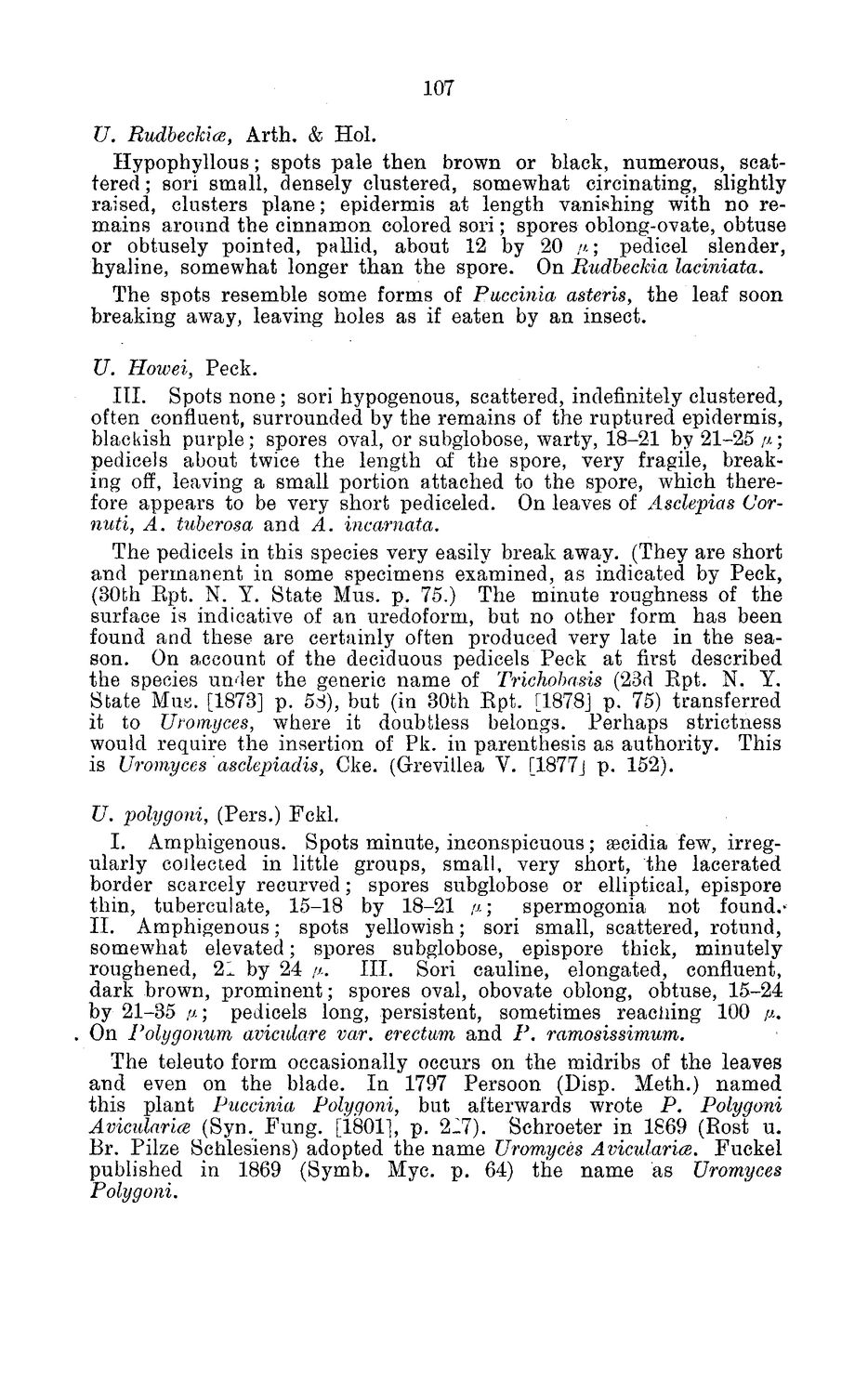| |
| |
Caption: Board of Trustees Minutes - 1884
This is a reduced-resolution page image for fast online browsing.

EXTRACTED TEXT FROM PAGE:
107 U. Rudbeckics, Arth. & Hoi. Hypophyllous; spots pale then brown or black, numerous, scattered ; sori small, densely clustered, somewhat circinating, slightly raised, clusters plane; epidermis at length vanishing with no remains around the cinnamon colored sori; spores oblong-ovate, obtuse or obtusely pointed, pallid, about 12 by 20 //; pedicel slender, hyaline, somewhat longer than the spore. On Rudbeckia laciniata. The spots resemble some forms of Puccinia asteris, the leaf soon breaking away, leaving holes as if eaten by an insect. U. Howei, Peck. III. Spots none; sori hypogenous, scattered, indefinitely clustered, often confluent, surrounded by the remains of the ruptured epidermis, blackish purple; spores oval, or subglobose, warty, 18-21 by 21-25 /i; pedicels about twice the length of the spore, very fragile, breaking off, leaving a small portion attached to the spore, which therefore appears to be very short pediceled. On leaves of Asclepias Cornuti, A. tuberosa and A. incamata. The pedicels in this species very easily break away. (They are short and permanent in some specimens examined, as indicated by Peck, (30th Ept. N. Y. State Mus. p. 75.) The minute roughness of the surface is indicative of an uredoform, but no other form has been found and these are certainly often produced very late in the season. On account of the deciduous pedicels Peck at first described the species under the generic name of Trichobasis (23d Ept. N. Y. State Mus. [1873] p. 5S), but (in 30fch Ept. [187.8J p. 75) transferred it to Uromyces, where it doubtless belongs. Perhaps strictness would require the insertion of Pk. in parenthesis as authority. This is Uromyces asclepiadis, Cke. (Grevillea V. [1877j p. 152). U. polygoni, (Pers.) Fckl. I. Amphigenous. Spots minute, inconspicuous; aecidia few, irregularly collected in little groups, small, very short, the lacerated border scarcely recurved; spores subglobose or elliptical, epispore thin, tubercuiate, 15-18 by 18-21 /i; spermogonia not found.* II. Amphigenous; spots yellowish; sori small, scattered, rotund, somewhat elevated; spores subglobose, epispore thick, minutely roughened, 21 by 24 /*. III. Sori cauline, elongated, confluent, dark brown, prominent; spores oval, obovate oblong, obtuse, 15-24 by 21-35 fi.; pedicels long, persistent, sometimes reaching 100 /*. On Polygonum aviculare var, erectum and P. ramosissimum. The teleuto form occasionally occurs on the midribs of the leaves and even on the blade. In 1797 Persoon (Disp. Meth.) named this plant Puccinia Polygoni, but afterwards wrote P. Polygoni AvieuUiria (Syn. Fung. [1801], p. 2:7). Schroeter in 1869 (Eost u. Br. Pilze Schlesiens) adopted the name Uromyces Avicularice. Fuckel published in 1869 (Symb. Myc. p. 64) the name as Uromyces Polygoni,
| |